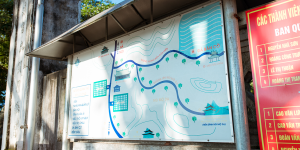
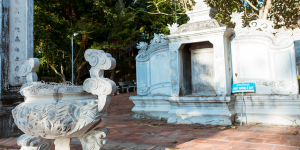
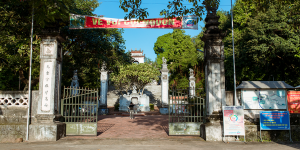
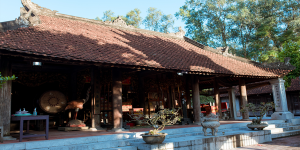
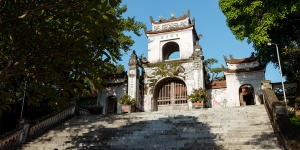
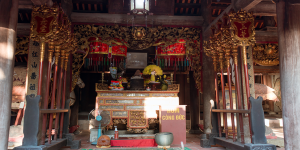
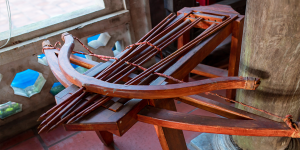
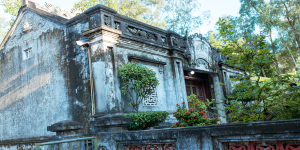
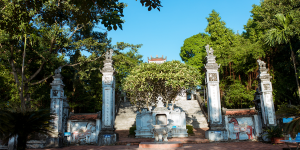
Camera tour
Price: Free
Time to visit a place: 120 phút
Open Time: 7:00 AM - Close Time: 6:00 PM
Address: Dien An Village, Dien Chau District, Nghe An Province
CUONG TEMPLE HISTORIC TOURIST SITE – DIEN CHAU DISTRICT
Located in the middle of Mo Da mountain, in Dai Hai range, Dien An commune, Dien Chau district, Nghe An province, Cuong temple is a famous sacred temple in Nghe An. The temple worships the king of Hung Vuong period, associated with a legend in the history of the nation's anti-foreign invasion: Thuc Phan An Duong Vuong. In the past, on Mo Da mountain, there were many peacocks living, so An Duong Vuong temple was called Cong temple, wrongly called Cuong temple..
Thuc Phan An Duong Vuong succeeded the Hung Kings, founded Au Lac country, built Co Loa citadel as the capital with many advances in construction technology and military art, in the first half of the 3rd century BC.
Trieu Da repeatedly invaded Au Lac, but thanks to the solid Co Loa citadel and powerful weapons, Trieu's army was defeated. Trieu Da had a plan to make peace, so that his son named Trong Thuy, came to propose to King Thuc's daughter - Princess My Chau. Trong Thuy stayed at hoouse of bridgegroom, discovered the military secret of the Au Lac country, returned to his country to report this secret. Trieu Da brought troops to fight, An Duong Vuong lost the battle, Co Loa citadel fell into enemy hands. An Duong Vuong and his daughter named My Chau ran to the South, they was chased by the enemy to Cua Hien (Dien Chau), the king thought that the princess had betrayed, so he cut My Chau and jumped into the sea to commit suicide.
According to folklore, it was originally a small temple in Cua Hien. In the Later of Le Dynasty, the People built a temple on Mo Da mountain and brought the tablet of Thuc An Duong Vuong to worship. Through the feudal dynasties, the temple was restored and embellished many times, until 1864, under King Tu Duc, the temple was restored on a large scale. In 1956, it was built two more left and right houses. In 2006, the restoration project of Cuong temple restored the original works and built some new auxiliary works.
Cuong Temple is an architectural work of quite massive scale, unique structure, ornate art.
The first impression to visitors when looking up from the temple yard through the steep stairs is the majestic three-gate architecture, standing in the middle of the sky. Three-gate architecture had an ancient, mossy and quiet beauty, with majestic architecture and delicate and vivid decorative motifs. The main gate was built in the shape of a rolling arch, the front was covered with a fierce tiger image, the upper floor was the 8th floor with yin and yang tile roofs, the banks are curved in the shape of knife-top. On the front, there was a great embossed painting "Quốc tế thượng từ" (First class celebrant state temple). On the roof was the shape of the sun. The second doors were also built in the style of eight roofs, decorated with floral motifs. The back of three gates was decorated lively with "Two dragons adoring the moon", "Carp crossed the gate", "dragon shaped bamboo".
Next are 3 buildings of lower - middle - upper hall with the structure of the letter "Tam". The lower hall is made of ironwood, 3 compartments, 2 acts, middle structure was in the style of the gong rack. On the roof and banks of the strip are elaborately decorated with dragons and phoenixes. The middle hall was stacked with eight roofs, knife-tops were decorated with stylized dragon heads. The house had 3 compartments, 2 acts, the system of pillars, posts, and beams were delicately carved with dragon, phoenix, lotus, and cloud motifs, creating softness for wooden architecture. This was the layout of the hall for workship the gods Kim Quy, Warrior-Captain Cao Lo and Princess My Chau. The upper hall was decorated with statues to worship King Thuc An Duong Vuong and his two confidants, the Upper hall is small in size but had beautiful architecture and unique visual arts. Especially on the front of the upper hall, with sophisticated embellishment techniques, ancient artisans created a beautiful letter that was supported by two peacocks with wingspan and bats joined together to create a lively decorative frill. The face of the letter standed out with 3 words "Cao phối thiên" (high compared to heaven). On both sides were squares filled with relics: dragon holding the longevity word , dragon shaped bamboo, shape of unicorn, shape of phoenix, juniper, chrysanthemum, bamboo, apricot. The roof was covered with two dragons adoring the moon. The upper hall had 3 compartments, quadrangle-style structure, system of pillars, trusses were carved, painted with the shape of a bending dragon, a phoenix holding a metal letter and soft clouds.
In addition to the sacredness and beautiful architectural landscape, Cuong Temple also attracts people by its annual traditional festival. The Cuong temple festival has been classified as "international" since ancient times, meaning that the royal court made sacrifices to pay tribute to and commemorate the merits of Thuc Phan An Duong Vuong in the early days of building and defending the country of the nation. Every 5 years, two main festivals are held on February 15 (lunar calendar) and August 15 (lunar calendar), including traditional rituals: water procession, carpentry ceremony, ceremony for adult son, and god procession. , sacrifice ceremony and standing ceremony, and folk games. Today, the Cuong Temple Festival is held annually from February 12 to 16 (lunar calendar) with ceremonies including procedures for mascots to receive their owners, farewell to the old year and welcome the new year, ceremony to ask for permission to open the ancestral festival, procession, sacrifice ceremony and thanksgiving ceremony and along with folk games, exciting and joyful modern games
With the sacred relics, great merits of Thuc Phan An Duong Vuong, beautiful architectural landscape, Cuong Temple was ranked as the National historical - cultural - architectural and artistic relic by Ministry of Culture and Information, (now known as Ministry of Culture, Sports and Tourism) according to Decision No. 09/QD-VH, dated 21/02/1975. Coming to Cuong Temple is going to a place where a part of the national roots is kept, to admire the ancients, admire the beautiful landscape of the ancient temple and relive the legendary period of history with legends about the magic crossbow, god Kim Quy, love story of princess My Chau, fairy chess board, Dau Can mountain…
Distance: 6.73 km
Distance: 7.49 km
Distance: 7.49 km
Distance: 8.09 km
Distance: 8.90 km
Distance: 8.91 km
Distance: 8.92 km
Distance: 8.94 km
Distance: 9 km
Distance: 9.04 km
Distance: 9.05 km
Distance: 9.10 km
Distance: 9.21 km
Distance: 9.28 km
Distance: 9.33 km
Distance: 10.72 km
Distance: 11.51 km
Distance: 11.93 km
Distance: 6.23 km
Distance: 8.36 km
Distance: 8.60 km
Distance: 8.96 km
Distance: 8.96 km
Distance: 9.18 km
Distance: 15.57 km
Distance: 15.63 km
Distance: 15.63 km
Distance: 15.85 km
Distance: 16.11 km
Distance: 16.15 km
Distance: 16.47 km
Distance: 17.03 km
Distance: 17.06 km
Distance: 17.51 km
Distance: 17.78 km
Distance: 18.25 km
Distance: 0 m
Distance: 10 m
Distance: 50 m
Distance: 3.16 km
Distance: 5.89 km
Distance: 6.07 km
Distance: 6.81 km
Distance: 7.50 km
Distance: 7.60 km
Distance: 7.74 km
Distance: 10.18 km
Distance: 11.09 km
Distance: 11.42 km
Distance: 12.27 km
Distance: 12.79 km
Distance: 13.19 km
Distance: 13.33 km
Distance: 13.60 km
Distance: 9.47 km
Distance: 15.32 km
Distance: 15.71 km
Distance: 16.47 km
Distance: 17.06 km
Distance: 17.66 km
Distance: 17.86 km
Distance: 17.96 km
Distance: 18.03 km
Distance: 18.16 km
Distance: 18.27 km
Distance: 18.36 km
Distance: 18.38 km
Distance: 18.65 km
Distance: 18.83 km
Distance: 18.98 km
Distance: 19.19 km
Distance: 19.52 km


